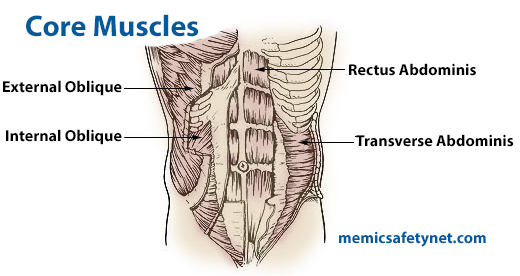Core Strength Comes From Deep Inside
As mentioned in a previous post, core strengthening is known to help build up the muscles that support the spine, as well as improve one’s balance. In other words, people with a stronger core have a better chance of avoiding common mishaps such as trips, slips and falls. Jobs that involved twisting, lifting and standing, depend heavily on the muscles that make up the core, as balance is required for all of these types of movements. Without a strong core, acts such as these can become both difficult and painful for workers. It is even necessary for workers who sit at desks to have a strong core in order to maintain good posture. If slumping occurs too often it can cause wear and tear on the spine, so practicing proper posture is important if you want to avoid aches and pains as well.
When it comes to strengthening your core, it is important to first know what it consists of in order to better understand how it can be improved, as well as why it should be. There are three different layers of muscle that make up the core; the upper abdominals (abs), the side muscles (obliques) and a deeper layer of muscle. Although all of the muscles that make up the core are important, the deep muscles are responsible for the majority of the functions the core is needed for. It is the deep muscle group that gives you the ability to balance, supports your spine and much more.
When working out, there is a difference between an ab workout and a core workout. In an ab workout you are only targeting the front side of the body, which means that the deep muscles are not getting as much use. In a core workout, however, you are targeting not only the front of your body but also the deep muscles and the erector spinae, which are the muscles that make up your back and glutes. An easy way to change an ab workout into a core workout is by including the action of stabilizing your body into the exercises. You can do this by utilizing a fitness ball when performing crunches for example, or by using a BOSU ball for lunges. Some other simple exercises that you can do to work the core are planks, side planks, supermans and the bridge. Exercises and instructions from Vanderbilt University Medical Center on how to strengthen the core can be found here.
The strength of the core is imperative for even the littlest tasks that the body executes. It is important to keep it fit in order to preserve the body for a longer period of time, and not cause unnecessary stiffness and soreness of the muscles. Performing core exercises can make everyday actions easier, as well as decrease the severity and frequency of mishaps. So make it a priority to work on your core even if it is only for ten minutes a day, it’s a terrific way to enhance your stretch breaks.
For more information on material handling, safe lifting and proper posture, check out the resources available to policyholders in the MEMIC Safety Director.

